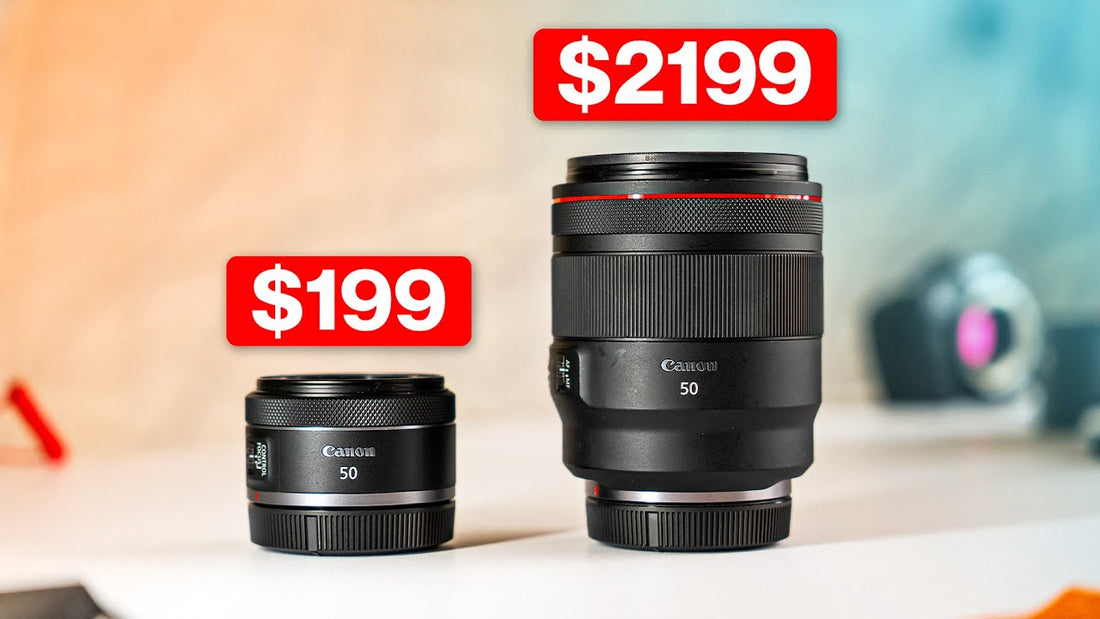
Canon RF 50mm f/1.8 vs f/1.2L: What's the $2000 Difference??
Is Canon's $2,000 50mm f1.2L lens really worth spending 10 times more than the popular "Nifty Fifty" 50mm f1.8? Today, we'll dive into a detailed comparison, looking at build quality, autofocus, sharpness, chromatic aberration, and of course, bokeh. Let's see if the extra money makes sense, especially for crop-sensor cameras like the Canon R7, R50, or R100.
Check out my full video comparison HERE
Build Quality: Premium vs. Practical
Right off the bat, there's no denying it—the Canon 50mm f1.2L lens is significantly larger, heavier, and built better. It features:
-
Substantial size and weight
-
Solid build with weather sealing
-
Larger front element and filter thread
In contrast, the 50mm f/1.8:
-
Much lighter and compact
-
No weather sealing
-
Makes your camera less front-heavy and easier to carry
Winner: Canon 50mm f1.2L (but consider the practicality of weight and size)
Stabilization & Autofocus
Neither lens has built-in stabilization, so there's no difference here. However, autofocus tells another story:
-
Canon 50mm f1.2L: Quieter, faster, and more reliable autofocus. Ideal for professional scenarios.
-
Nifty Fifty f1.8: Occasionally struggles, slightly slower and less accurate autofocus performance.
Winner: Canon 50mm f1.2L (especially important for professionals needing consistency)
Image Sharpness: Clinically Sharp vs. Good Enough
Sharpness is where the Canon 50mm f1.2L shines dramatically:
-
50mm f1.2L: Razor-sharp across the frame, even wide open at f1.2. Exceptionally sharp at corners and center, providing near-perfect clarity.
-
50mm f1.8: Decently sharp, especially when stopped down to f2.8 or f4. Wide open at f1.8, it isn't clinically sharp but still good enough for general photography.
However, side by side, unless making large prints or heavily cropping, most casual viewers won't notice the difference.
Winner: Canon 50mm f1.2L (but practically negligible difference for casual users)
Flaring & Chromatic Aberration
-
Flaring: Both lenses handle flares similarly, with no dramatic differences.
-
Chromatic Aberration:
-
50mm f1.2L: Excellent control, virtually no visible aberration even in challenging lighting.
-
50mm f1.8: Struggles wide open, visible aberration in high-contrast scenarios. Improves significantly when stopped down.
-
Winner: Canon 50mm f1.2L (clear advantage in controlling aberrations)
Bokeh: Smooth vs. Defined
When comparing background blur:
-
50mm f1.2L: Creamy, smooth, natural-looking bokeh.
-
50mm f1.8: Slightly busier and more defined bokeh, less smooth compared to the premium L lens.
Again, while the L lens looks better, most viewers won't notice or care about the subtle difference in everyday scenarios.
Winner: Canon 50mm f1.2L (for premium bokeh)
Is It Worth the Price?
If you're a professional photographer who:
-
Needs the absolute best image quality
-
Requires fast and reliable autofocus
-
Wants robust build quality for demanding situations
Then yes, the Canon 50mm f1.2L is worth the premium.
But for hobbyists, casual shooters, or those on a budget:
-
The Nifty Fifty f1.8 gives you around 80-90% of the performance at a fraction of the cost.
-
You'll get sharp photos, good background blur, and adequate autofocus for everyday use.
Final Verdict
The Canon 50mm f1.2L lens clearly outperforms the Nifty Fifty in every technical category. But at 10 times the cost, most photographers simply won't need the extra benefits.
Final Recommendation:
-
Professionals: You're better off with the pro features that the 50mm f1.2L offers.
-
Everyone Else: The nifty fifty 50mm f1.8 is a great performer at its price, and you can get great looking photos from it.
Ultimately, it comes down to your needs, your budget, and whether the extra quality and features justify the significant jump in price. For me personally, I'll stick with my nifty fifty and save the money!
